Bash Bish Falls
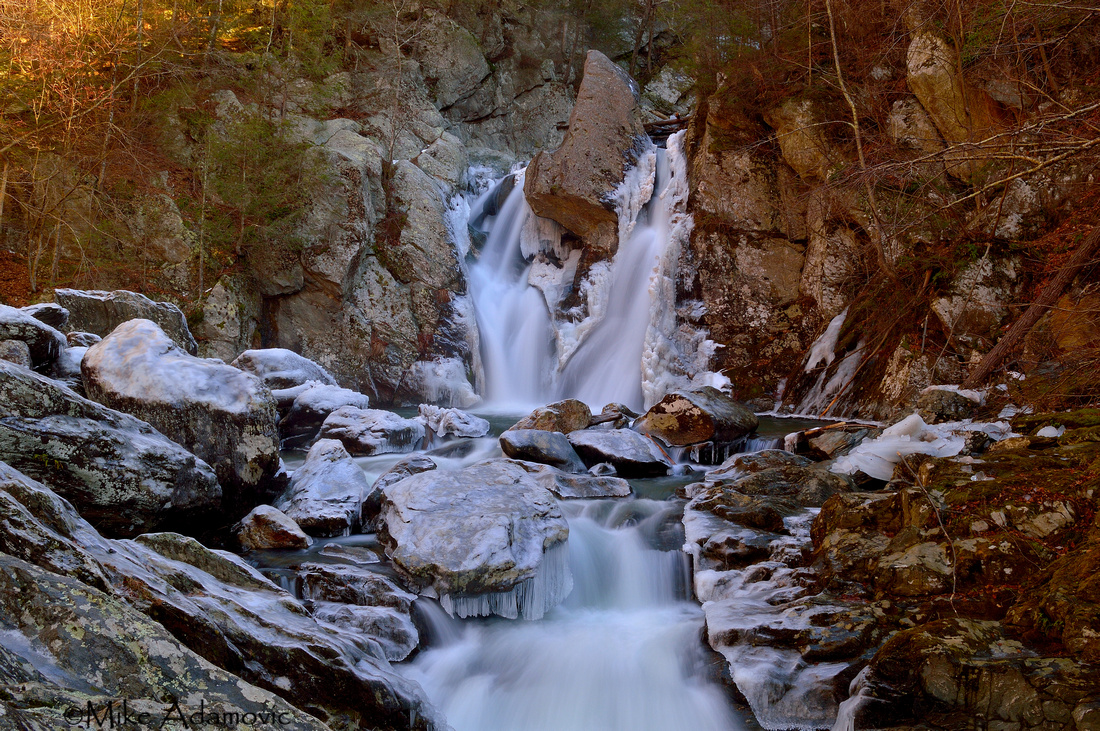

Hugging the border of New York and Massachusetts lies a raging cataract sequestered in a steep and rugged, yet sublimely beautiful ravine. The unusual titled Bash Bish Falls is Massachusetts highest waterfall, rising to 60 feet. Located in the extreme southwest of the state, it's easy for residents of New York to make a day trip, many of which, despite its presence in New England, classify it as a natural landmark of the Hudson Valley. For as long as records have been kept (and actually much longer than that) people have made pilgrimages to this spot to seek out and bask in the mighty and awe-inducing power of nature.
There are conflicting reports of how this waterfall came to be named. Some say it's so-called due to a supposed Indian witch being executed at the spot, her name being Bash Bish. While the other, more believable explanation, derives, according to a 19th century author, "from an Indian onomatopoetic name," or in other words, garnering its name from the sound that falling water makes. In any case, it's certainly a unique name that most people are not likely to forget (with the exception of possibly reversing the order of the words).
Before the colonization of the continent by Europeans, Native Americans undoubtedly visited the falls regularly, as these sites were believed to be the sacred abodes of spirits, a place to commune with the other side. The only direct evidence that exists which attests to their reverence of the place is a Mohican legend, if it is indeed genuine and not something crafted during the 19th century by romantic-style writers. The sad tale tells of multiple deaths occurring at the waterfall by supernatural forces (the story is appended at the end).
When this sequestered spot become relatively accessible in the 1800's upon the introduction of the railroad, crowds of curious visitors would make the trip up from New York City to spend a day in the charming Taconic-Berkshire range. Numerous magazines and traveler's handbooks made mention of the area and, of course, the famous waterfall. "Bash-Bish... is one of the finest points of observation between New York and Montreal," the author of Health and Pleasure on "America's Greatest Railroad" stated in his passage of the falls, one of numerous natural features he detailed. The nearby station at the Copake Iron Works allowed passengers to disembark, walk up the winding road to the falls on foot, and be back in the metropolitan bustle of the city by nightfall. Despite the close proximity of the falls to the station, one guide book warned that "one requires a good foot, a strong hand, and a clear head" to those unaccustomed to the ruggedness of the area, which was significantly more extreme before the aid of modern roads and an improved trail system.
Several publications also urged, or at the very least, described in vivid detail wild expeditions through parts of the upper ravine that park officials today would most likely discourage for safety concerns. One of the most sought after features was that of the "Eagle's Nest." This lofty viewpoint, a "blackened crag," towers "more than three hundred feet into the air" and "broods over the abyss." The journey up it was recorded as "perilous in the extreme" by one intrepid adventurer in the 1850's that also recalled that "scarce a foot-hold could be obtained, and we clung to the straggling plants in terror as we went." Despite the difficulty of reaching the spot, an unrivaled view emerged of the ravine and surrounding countryside. Standing on the edge of the precipice and looking down towards the falls, the people below resembled the miniature "Lilliputians of Gulliver's Travels."
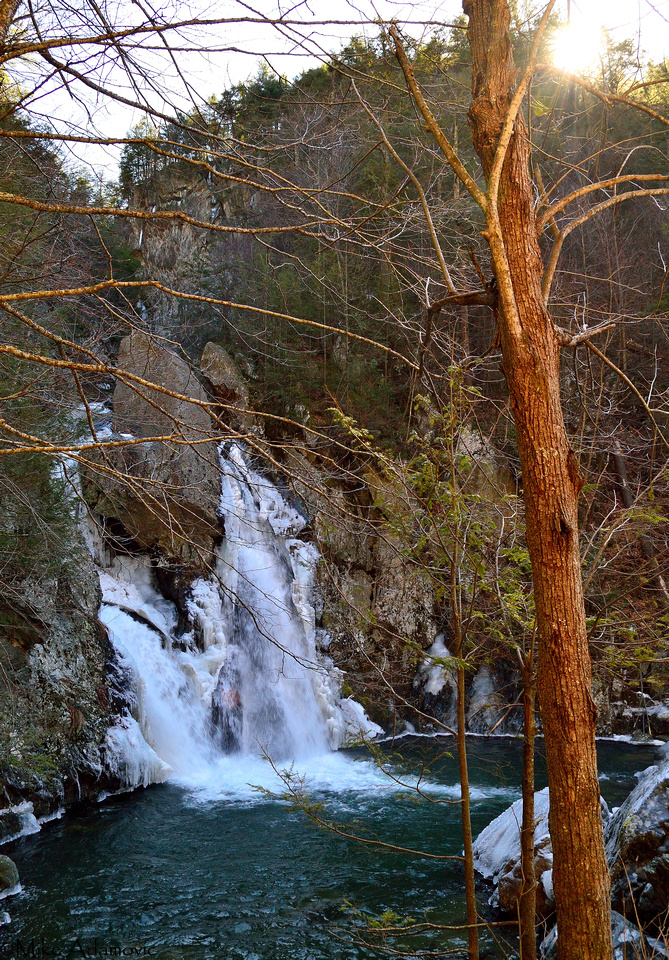

"Profile Rock," a rock edifice resembling the face of a man, and the "Look-Off," another viewpoint of "high rocks on the south bank of the gorge," adjacent to the "Eagle's Nest" attracted additional visitors seeking an adventure.
As excitement best describes the overhanging crags and ledges, so does beauty and "majestic loveliness" most aptly portray Bash Bish. Apart from the impressive height of the falls, what's really eye-catching about the scene is the titanic boulder that sits at the very edge of the cliff and diverts the flow of the raging brook. The water is divided as it tumbles over the edge, and then powerfully reunites into a single powerful stream again just before entering the swirling, emerald tinted plunge pool that "seethes and boils and bubbles like a great cauldron." Its elegance supersedes other waterfalls of the region.
And like the unusual gap in the brook caused by the island-like boulder, the narrow ravine briefly disappears below the falls, expanding into a spacious glen—a fortuitous feature that enhances the scene and allows nature's remarkable handiwork to be adequately viewed. Crowds can gather in the natural amphitheater to simply take in the view, to photograph, and in years past to paint, all while enjoying ample space to freely move about. The heavy mist that exudes from the falling water is refreshing on a hot summer's day as it's gently blown this way and that by the fragrant mountain breezes that sweep down the ravine, similarly to the cool flowing water of the foaming brook.


Over the years, many have compared the beguiling intensity of the spot to the forces of magic. These "fairy falls" and surrounding countryside, endowed with Elysian qualities, seemed too surreal to simply house common arrays of wildlife, such as squirrels and deer. Rather, fanciful imaginations populated the region with supernatural entities, from phantoms of Indian myth to "fairy queens" that lived in "elfin palaces beneath the earth" imagined by 19th century romantics.
Enraptured visitors were often at a loss of words. "I feel the paucity of description for delineating such scenery," one professor unabashedly admitted. Another "longed for the language of a poet" in attempt to express his elated emotion. And yet others felt the scene was practically indescribable. Not content that the present words of the English language would do it justice, one adventurer wished that "someone would invent a new vocabulary" for the purpose.
And there were those who required no words to convey Bash Bish's grandeur. Painters flocked to the falls in substantial numbers throughout the 1800's. The Hudson River School artist John Frederick Kensett, produced perhaps the finest rendering in 1865. The painting shows a darkened glen, with summer storm clouds amassing overhead, adding yet another layer of wildness and intensity to the scene.
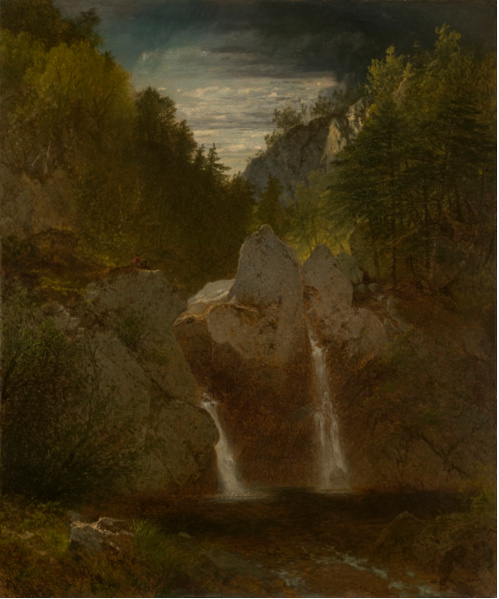

Other notable individuals who paid homage to Bash Bish consisted of the abolitionist and clergyman Henry Ward Beecher, along with the Transcendentalists Henry David Thoreau and William Ellery Channing. "I would willingly make the journey once a month from New York to see it," Beecher wrote. While little documentation survives of Thoreau's visit, the prolific writer did make a brief mention of it in his work, A Yankee in Canada. This set of falls made an obvious impression on him; when he spoke of "interesting" waterfalls of the Northeast, he noted only two: Kaaterskill Falls and Bash Bish.
The entire area surrounding the ravine is ideal "as a botanical hunting ground." Numerous uncommon to rare plant species are scattered along the brook and throughout the nearby forests. The combination of shade, dampness, and a variety of soil types has resulted in the presence of rare mosses, orchids, and other flowers. The unusual conditions of the mountain slope provide key habitat for species which would otherwise be absent in the more typical forest regimes of the region.

 Little rivulets which continually stream down the cliff-like slopes that encircle the plunge pool feed mats of plush mosses that densely coat the rock. On a typical day water drains off these mats like water streaming off the hair of someone just exiting the shower. One enterprising botanist had enough luck with finding rarities here that she wrote an article for inclusion in a botanical journal titled "Rare Mosses of Bashbish Falls."
Little rivulets which continually stream down the cliff-like slopes that encircle the plunge pool feed mats of plush mosses that densely coat the rock. On a typical day water drains off these mats like water streaming off the hair of someone just exiting the shower. One enterprising botanist had enough luck with finding rarities here that she wrote an article for inclusion in a botanical journal titled "Rare Mosses of Bashbish Falls."
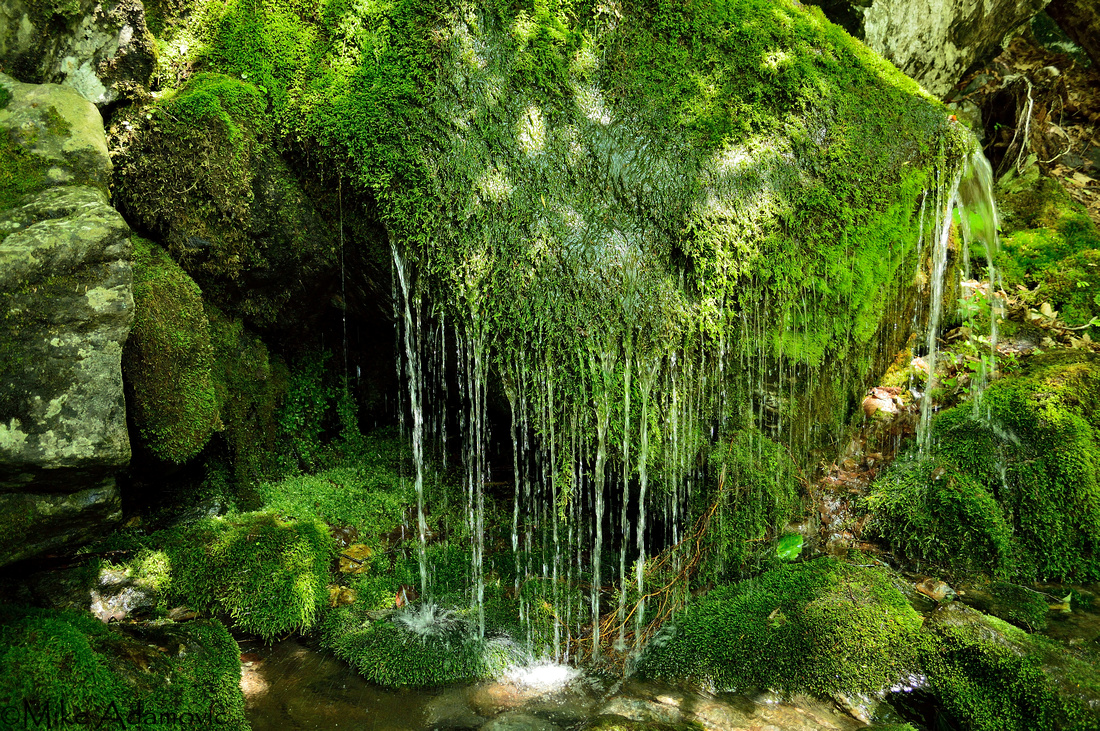

In May and June one traipsing through the "upper end of the gorge" may be fortunate enough to stumble upon small clusters of the wild blue clematis. This delicate flowering vine is often found in open light twisting around riparian trees or clinging to talus or rock ledges imbued with a hint of calcium. Orchids populate the shady forest interior, adding bursts of yellow, pink, and purple to the drab leaf litter of the understory.
Before the introduction of a deadly exotic fungus in the early 1900's, impressive specimens of the American chestnut once graced the mountains here. "Chestnut formed a good percentage of the lower level growths and yearly yielded large crops until the disease made its appearance," Sereno Stetson wrote in the botanical publication, Torreya in 1913. "These beautiful trees," he continues, "two to three feet in diameter, are now decaying masses." While these mammoth and stately trees that provided tasty nuts to the area's people and wildlife alike no longer rise into the upper reaches of the canopy, traces of them can still be seen. Some roots from infected trees have survived, and it is not uncommon to see resprouts. However, as soon as they emerge above ground the fungus once again begins its insidious attack. Chestnut trees nowadays almost never achieve heights of more than 30 feet.
While a majority of visitors seek out the mountains of western Massachusetts to see this popular set of cascades, it's important not to be overtaken by tunnel vision and miss out on the rest of the scenery. An "endless variety of attractions" await those who do even the most minor of exploring of the area's eclectic environs. Just be mindful of the rugged terrain while doing so. Along with being one of the most beautiful waterfalls of the Northeast, it's also one of the most deadly. Over 25 deaths have been recorded around Bash Bish during the last 100 years. Let's not add another ghost to the already crowded bunch. Although, I could think of places much worse to spend eternity than near this divine waterfall.
***
The Legend of Bash Bish
Deemed guilty of adultery, a young woman by the name of Bash Bish was condemned to die by members of her tribe. The Mohicans viewed this act as an unpardonable crime, despite the allowance of polygamy and divorce in their society. Because she was well-liked, and no one in her tribe could bear the thought of being personally responsible for causing her demise, it was determined to consign her fate to the forces of nature. Her unusual execution was to take place at the site of a large, rapidly flowing waterfall in the western Taconics. She was to be strapped into a canoe and sent to plunge over the falls, where she would undoubtedly be dashed to pieces on the sharp rocks below, afforded little protection from the thin-skinned birch bark canoe she was destined to ride in.
At sunrise of the execution day, Bash Bish was tightly bound into the canoe, and only moments away from being launched into the foaming brook, when a dense fog quickly swept down the narrow ravine, obscuring everything. Out of view, Bash Bish somehow managed to undo her restraints and free herself. Knowing that she could never return to her friends or family, and finding the idea of having to start anew elsewhere absolutely repugnant, she decided to accept the punishment of death. However, it was to be done on her terms.
Just as she clambered to the top of a massive boulder sitting at the edge of the precipice that divides the falls, the fog dissipated as quickly as it had arrived, and Bash Bish was once again in full public view. Everyone from her tribe was in attendance, gathered around the edge of the deep plunge pool at the base of the falls, including her infant daughter, White Swan.
As she stood atop the crag silently gazing down at her people, a mass of butterflies, as numerous as the individuals congregated to watch her die, appeared seemingly from thin air and began to encircle her head like a crown. With every pass they picked up speed. What began as light fluttering quickly intensified into a frenzied swarm of activity. When the shocked onlookers half-expected a tornado to erupt from the ceaseless and turbulent rotation, Bash Bish leapt off the cliff, with the butterflies following her into the mist of the raging cataract. Though a long and thorough search of the plunge pool took place, her body was never recovered. Because of the sudden fog, prolific and strange behavior of the butterflies, and her vanishing without a trace, people began to suspect that Bash Bish was a witch.
***
Despite her mother's tarnished reputation, White Swan managed to do quite well for herself. She had grown to become as lovely as mother had been. Upon reaching adulthood, she married the son of the tribe's chief. For years they lived in near perfect contentment. As time wore on, however, things took a turn for the worse when it became obvious that White Swan would never be able to bear her husband any children. Needing an heir to carry on his family's legacy, he was forced to take an additional wife.
Overcome with sadness and needing an escape from the village, she began to take long walks into the wilderness. One day her aimless wandering brought her back to the fateful waterfall, a spot she hadn't visited since her days as an infant. Her relatives did all in their power to keep her away from the area, which since the odd occurrences of her mother's botched execution, was regarded with an equal mixture of awe and apprehension.
That night as she lay in a deep sleep, her mind was overcome with a vivid dream of her mother beckoning for her to return to the site of the waterfall. In the morning she did as the dream commanded and visited the spot again. In her society, dreams were not to be dismissed; rather, they were thought to be divine revelations that were to be carefully analyzed and heeded.
Day after day, White Swan sat along a boulder at the brim of the falls, dangerously close to the swift current, awaiting another message from Bash Bish, as the dream foretold would come to her at this very spot. Her husband worried with the depressed and fixated state of his wife—who he still loved with all his heart—did everything in his power to improve her spirits. Each day as she hovered at the edge of the cliff despondent, and mindlessly staring into the churning water below, he would bring her a new gift from the forest, a small token of his affection.
On the tenth day, he came across a rare find. In a grove of cardinal flowers a pure white butterfly was alighted on one of the fiery blossoms. With the stealth that was natural to his race, he quickly crept up to the insect unnoticed and clutched it, imprisoning it in the hollow of his hands. Instantly, he set off to present his proud catch to White Swan. No sooner had he given the rare insect to her, she began to hear her mother's voice echoing from the plunge pool below. In a beautiful, intoxicating tone, Bash Bish urged her daughter to join her in the spirit world, where no worries or strife, she promised, could ever touch her. White Swan obeyed and stepping off the ledge, disappeared into the mist, the white butterfly trailing close behind. Her husband rushed to pull her back, but it was too late. In his eagerness to save her he had disregarded his own safety and, slipping on the slick, moss covered rocks, tumbled down the falls. As happened with her mother before her, no trace of White Swan was ever found. Her husband's badly battered and broken body, however, was cast up from the emerald-tinted pool and washed ashore.
Visitors to the falls today, especially on drab, foggy days occasionally report encounters with the supernatural. Smiling faces are said to be seen in the foam of the plunge pool, while alluring, siren-like voices sometimes whisper from the spray of the tumbling water. A number of the numerous deaths that have occurred in the vicinity over the years have been attributed to these ghostly manifestations. Some say that they're the mischievous workings of an evil witch; others, that they're derived from melancholy spirits who dwell beneath the water, eager to acquire new companions to assuage their own loneliness. Either way, this curious waterfall is one best approached with a healthy dose of caution and trepidation.
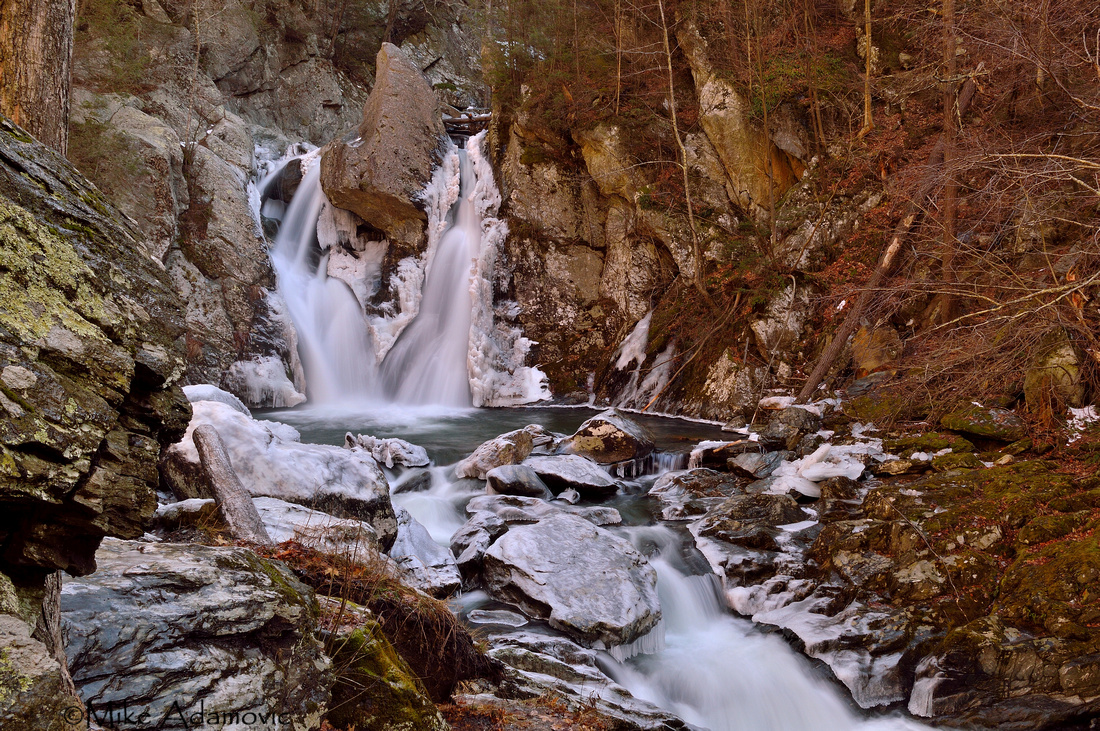
 "Towards evening I left Bash Bish, feeling that although I had visited higher mountains than the Taconic range, and explored deeper ravines, yet I never saw so much wildness of scenery comprised within the same limits that I did here." -M., Supplement to the Courant, 1854
"Towards evening I left Bash Bish, feeling that although I had visited higher mountains than the Taconic range, and explored deeper ravines, yet I never saw so much wildness of scenery comprised within the same limits that I did here." -M., Supplement to the Courant, 1854
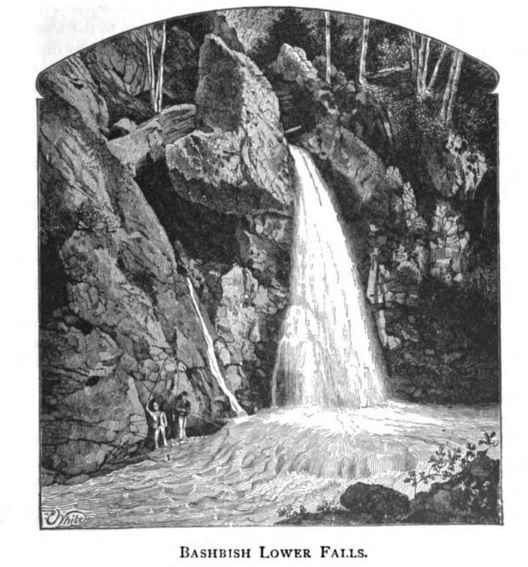

Comments
Jeff
http://www.printradiant.com | http://www.printlinkage.com | http://www.hitsticker.com | http://www.stickermac.com